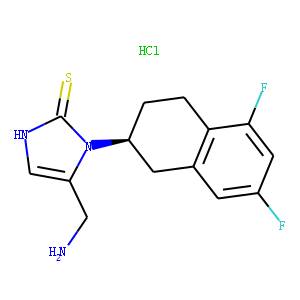| Reference | 1. Prog Neuropsychopharmacol Biol Psychiatry. 2015 Jun 3;59:40-8. doi:
10.1016/j.pnpbp.2015.01.009. Epub 2015 Jan 17. <br />
<br />
Evaluation of the dopamine β-hydroxylase (DβH) inhibitor nepicastat in
participants who meet criteria for cocaine use disorder. <br />
<br />
De La Garza R 2nd(1), Bubar MJ(2), Carbone CL(2), Moeller FG(3), Newton TF(4),
Anastasio NC(5), Harper TA(6), Ware DL(7), Fuller MA(8), Holstein GJ(8), Jayroe
JB(7), Bandak SI(9), Reiman KZ(9), Neale AC(9), Pickford LB(9), Cunningham KA(5). <br />
<br />
Author information: <br />
(1)Menninger Department of Psychiatry and Behavioral Sciences, Baylor College of
Medicine, Houston, TX, United States. Electronic address: [email protected].
(2)Center for Addiction Research, University of Texas Medical Branch, Galveston,
TX, United States.
(3)Center for Addiction Research, University of Texas Medical Branch, Galveston,
TX, United States; Institute for Drug and Alcohol Studies, Addiction Medicine,
Virginia Commonwealth University, Richmond, VA, United States.
(4)Menninger Department of Psychiatry and Behavioral Sciences, Baylor College of
Medicine, Houston, TX, United States.
(5)Center for Addiction Research, University of Texas Medical Branch, Galveston,
TX, United States; Department of Pharmacology and Toxicology, University of Texas
Medical Branch, Galveston, TX, United States.
(6)Department of Pharmacology and Toxicology, University of Texas Medical Branch,
Galveston, TX, United States.
(7)Center for Addiction Research, University of Texas Medical Branch, Galveston,
TX, United States; Department of Internal Medicine, University of Texas Medical
Branch, Galveston, TX, United States.
(8)Center for Addiction Research, University of Texas Medical Branch, Galveston,
TX, United States; Department of Psychiatry and Behavioral Sciences, University
of Texas Medical Branch, Galveston, TX, United States.
(9)Biotie Therapies, Inc. (formerly Synosia Therapeutics), South San Francisco,
CA, United States. <br />
<br />
In the present study, we tested the hypothesis that the potent and selective
dopamine-β-hydroxylase (DβH) inhibitor nepicastat would have minimal effects on
cardiovascular and pharmacokinetic parameters associated with cocaine
administration and would reduce the positive subjective effects produced by
cocaine. We conducted a double-blind, placebo-controlled, inpatient study of oral
nepicastat (0, 80 and 160mg) concurrent with intravenous (IV) cocaine (0, 10, 20
and 40mg) in non-treatment seeking participants who metcriteria for cocaine use
disorder. Safety analyses revealed that nepicastat was well-tolerated and there
were no differences in adverse events observed after nepicastat plus cocaine vs.
cocaine alone. In addition, the pharmacokinetic properties of cocaine
administration were not altered by nepicastat treatment. Cocaine-induced
cardiovascular and subjective effects were evaluated for completers in the cohort
randomized to nepicastat (n=13) using a within-subjects statistical analysis
strategy. Specifically, the cardiovascular and subjective effects of cocaine were
assessed in the presence of placebo (0mg), 80mg of nepicastat or 160mg of
nepicastat on study Days 4, 8 and 12, respectively. Analyses revealed a main
effect of nepicastat to reduce several cocaine-induced positive subjective
effects. Taken together, these data indicate that nepicastat is safe when
co-administered with cocaine and may suppress its positive subjective effects,
and may be viable as a pharmacotherapy for treatment of cocaine use disorder. <br />
2. Br J Nutr. 2013 Oct;110(8):1524-33. doi: 10.1017/S0007114513000743. Epub 2013 Apr
8. <br />
<br />
The dopamine β-hydroxylase inhibitor, nepicastat, suppresses chocolate
self-administration and reinstatement of chocolate seeking in rats. <br />
<br />
Zaru A(1), Maccioni P, Colombo G, Gessa GL. <br />
Author information: <br />
(1)Neuroscience Institute, National Research Council of Italy, Section of
Cagliari, S.S. 554 km. 4,500, I-09042 Monserrato (CA), Italy. <br />
<br />
Craving for chocolate is a common phenomenon, which may evolve to an
addictive-like behaviour and contribute to obesity. Nepicastat is a selective
dopamine β-hydroxylase (DBH) inhibitor that suppresses cocaine-primed
reinstatement of cocaine seeking in rats. We verified whether nepicastat was able
to modify the reinforcing and motivational properties of a chocolate solution and
to prevent the reinstatement of chocolate seeking in rats. Nepicastat (25, 50 and
100 mg/kg, intraperitoneal) produced a dose-related inhibition of operant
self-administration of the chocolate solution in rats under fixed-ratio 10 (FR10)
and progressive-ratio schedules of reinforcement, measures of the reinforcing and
motivational properties of the chocolate solution, respectively. The effect of
nepicastat on the reinstatement of chocolate seeking was studied in rats in which
lever-responding had been extinguished by removing the chocolate solution for
approximately 8 d. Nepicastat dose-dependently suppressed the reinstatement of
lever-responding triggered by a /’priming/’ of the chocolate solution together with
cues previously associated with the availability of the reward. In a separate
group of food-restricted rats trained to lever-respond for regular food pellets,
nepicastat reduced FR10 lever-responding with the same potency as for the
chocolate solution. Spontaneous locomotor activity was not modified by nepicastat
doses that reduced self-administration of the chocolate solution and regular food
pellets and suppressed the reinstatement of chocolate seeking. The results
indicate that nepicastat reduces motivation to food consumption sustained by
appetite or palatability. Moreover, the results suggest that DBH inhibitors may
be a new class of pharmacological agents potentially useful in the prevention of
relapse to food seeking in human dieters.
|

